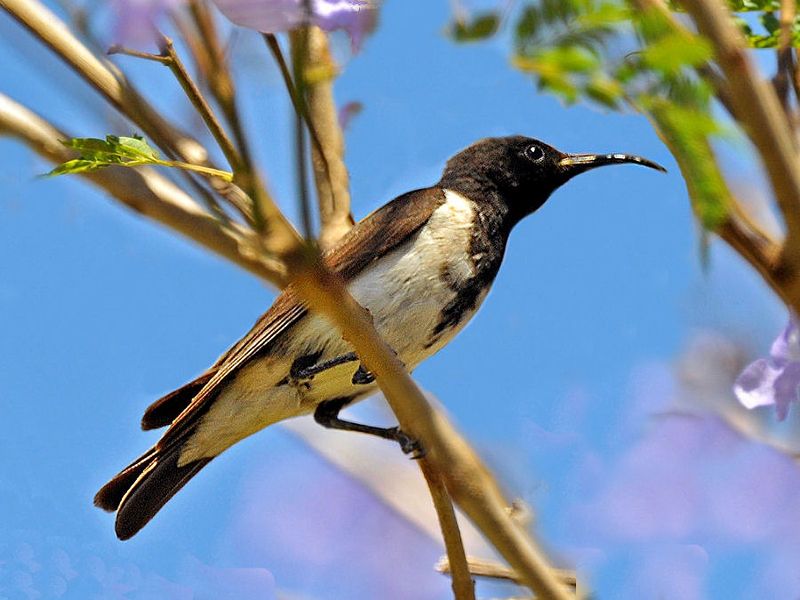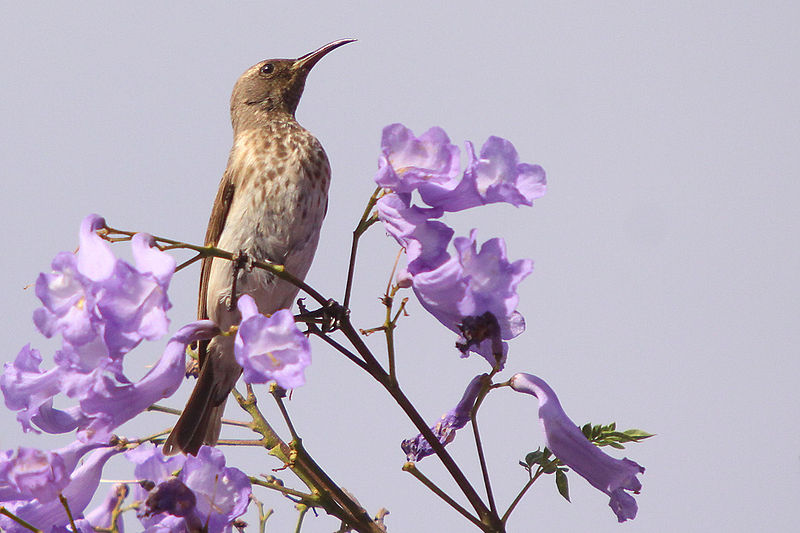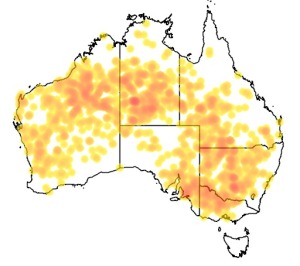Colours
Distinguishing features
It is a small honeyeater with a long slender down-curved bill, a small rounded head and slender neck set on a plump body, and a short, slightly cleft tail. It has relatively long, pointed wings compared with other Meliphagidae, and very long wings for such a small bird, the development of which has been attributed to its feeding behaviour of flying between shrubs and hovering over flowers.
The species is strongly sexually dimorphic. Adult males are black and white, with a black head, neck, wings and upperparts, and a black stripe running down from the centre of the chest to the abdomen, and with a white belly, flanks and under-tail coverts.
The female’s crown, ear coverts and upper parts are buff brown, scalloped paler, with a pale eyebrow, and the chest is speckled grey-brown grading into a dull white belly.
In both male and female the iris is dark brown and the bill and legs blackish brown.
Immature birds are similar to the adult female, however the upper breast and throat tend to be more uniform and the base of the bill is paler. Immature birds are not separable from adults at a distance. (Wikipedia)
Size
- From 10 cm to 12 cm (Length of specimen)
Wingspan
- Wingspan data is not yet available.
Synonyms
Distribution
Distribution and habitat preferences
It is a bird of the dry inland of Australia, being generally widespread if scattered in western Queensland and New South Wales to the South Australian border and occasionally recorded in the Victorian Mallee and Wimmera regions. In South Australia, it occurs in the south-east and it is widespread in the central and northern regions of Western Australia, with some rare records in the south near Kalgoorlie. In the Northern Territory it is widespread around Alice Springs, with some vagrants to the Top End.
It is dependent on the presence of the emu bush Eremophila longifolia and related species. As a result, it is found in open woodlands and shrublands of arid and semi-arid regions, as well as in mulga or mallee woodlands, and it will also be found in spinifex savanna where flowering shrubs such as grevilleas and paperbarks occur. It has been noted that it is able to locate emu bushes, even when clumps consisted of only two or three trees and were separated by many miles of country, which suggests the importance of this plant-bird association. (Wikipedia)
Diet
It feeds on nectar, probing flowers and foliage with its long fine bill. It is mainly found in the crowns of eucalypts, at clumps of mistletoe or in shrubs, especially emu bushes Eremophila. Observations over a twelve month period in South Australia recorded Black Honeyeaters visiting the flowers of Eremophila longifolia, Eremophila oppositifolia, Eucalyptus incrassata, and Grevillea ilicifolia. They were also frequently observed hawking for small insects. The Black Honeyeater hovers briefly around flowers when feeding. (Wikipedia)


